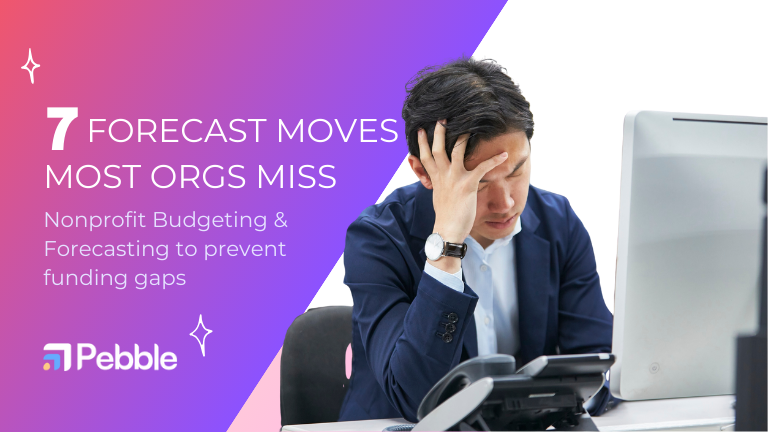Nonprofit Budgeting: 7 Forecast Moves Most Orgs Miss
A cause-driven approach to planning with clarity and acting with confidence.
Forecasting isn’t just a bigger budget—it’s a living plan that helps your nonprofit see around corners. Below, we break down each “silo” that drives your numbers—revenue, expenses & payroll, restrictions & compliance, cash flow, programs & outcomes, and reporting—then give you crisp, actionable steps to build a reliable forecast and a sample nonprofit budget you can trust.
1) Revenue (Grants, Gifts, Earned Income)
Forecasting revenue is about probability, timing, and restrictions—not wishful thinking. Treat each source differently and document assumptions so leadership and funders know what’s real vs. at-risk.
Actionables
- Score each revenue line by confidence (committed, likely, stretch) and timing; track it weekly in Budgeting & Forecasting.
- Separate restricted vs. unrestricted revenue and attach rules/allowables to each grant inside the budget object (Grant Management Guide).
- Create scenarios (base/best/worst) and assign different grant win-rates; compare side-by-side in Pebble’s what-ifs (Budgeting).
- Link fundraising pipeline assumptions to the Fundraising Efficiency KPI to keep expectations grounded (metric guide).
2) Expenses & Payroll (The Biggest Lever)
Salaries, FTE allocations, and step changes (new hires, merit increases) drive most variances. Forecast at the level you make decisions—program, contract, and team.
Actionables
- Allocate staff FTE by program/contract and auto-roll up to org view—no parallel spreadsheets (Budgeting).
- Pre-load known step changes (hire dates, raises, benefits) to avoid month-end surprises.
- Use the Payroll-to-Program Allocation KPI to verify direct vs. admin splits (KPI article).
- Track unit-cost drivers (classes served, households assisted) for driver-based expense forecasts.
3) Restrictions & Compliance (Prevent Overspend/Underspend)
Each award has categories, caps, and deadlines. Your forecast should include those rules so you spend every allowable dollar—and never the unallowable ones.
Actionables
- Encode grant categories, caps, indirect rates, and deadlines; enable alerts for pacing and category limits (Budgeting).
- Monitor utilization by contract to catch underspend early; route reallocation requests for approval (Maximise Grant Revenue use case).
- Tie deliverables/milestones to budget timing to keep spend aligned with progress (Program Director & Manager).
4) Cash Flow (Runway > Paper Surplus)
Accrual surpluses don’t pay bills—cash does. A forecast must model when money arrives vs. when you must spend it.
Actionables
- Build a cash-timed view of inflows/outflows alongside accruals; include reimbursement lag assumptions (Budgeting).
- Track Average Bank Balance and Survival Ratio / Runway KPIs on your forecast dashboard to watch liquidity trends (Average Bank Balance, Survival Ratio).
- Add a reserve target (e.g., months of ops) and show progress each month in Reporting Studio (Reporting).
5) Programs & Outcomes (Tie Mission to Money)
Forecasting isn’t just finance—it’s operations. Connect volumes, outcomes, and staffing to your budget so leaders can decide with context.
Actionables
- Build program-level budgets and rollups; publish PM dashboards so managers self-serve BvA and forecast changes (Program Director & Manager).
- Use driver-based forecasting (enrollments, visits, sessions) to anticipate cost shifts when volumes change.
- Keep a Performance by Program view for quick storylines in board packets (program insights).
6) Reporting & Stakeholders (Clarity Wins Renewals)
Board and funders expect a clear through-line: assumptions → forecast → actions. Make reports consistent, visual, and tied to live data.
Actionables
- Standardize a board packet with 1-page “Insight Blocks” (what changed, why, and what we’re doing next) in Reporting Studio.
- Publish grant-specific budget reports with pacing, category caps, and deliverables (Budgeting).
- Use scenario pages in Reporting to compare base/best/worst with callouts for hiring, program scale, and cash runway.
A Simple Structure for a Sample Nonprofit Budget
If you’re creating a sample non profit budget or seeking a nonprofit budget example to start from, keep the structure decision-friendly and funder-ready.
Actionables
- Organize by Program / Admin / Fundraising, with a drill-down to contract/grant lines (Budgeting).
- Include a sample operating budget for nonprofit organizations with monthly phasing and cash timing.
- Add a sample program budget (nonprofit) per flagship program—mapped to funder categories and caps.
- Save as annual budget for nonprofit organizations (base case); duplicate for best/worst; store all three in Pebble’s scenarios.
- For startups, create a sample budget for nonprofit startup with runway and key hire milestones.
Rolling Forecast Cadence (12–18 Months)
Budgets go stale; rolling forecasts keep decisions current.
Actionables
- Update monthly; always keep 12–18 months ahead (Budgeting).
- Re-score revenue confidence, refresh staffing/FTE plans, and re-compute runway.
- Lock a quarterly reforecast for the board, with scenario deltas visualized in Reporting).
KPIs to Anchor Every Forecast
Forecasts are only as good as the signals you watch.
Actionables
- Runway / Survival Ratio, Average Bank Balance, Fundraising Efficiency, Program BvA with variance drivers (quick reads in the Pebble blog: Survival Ratio, Average Bank Balance, Fundraising Efficiency).
- Create alert thresholds for deficits, underspend, and cap breaches (Budgeting).
Put It Together in Pebble
Pebble is built for nonprofit budgeting, budget planning for nonprofit organizations, and financial forecasting for nonprofits—turning spreadsheet chaos into a single source of truth.
Actionables
- Build the operating budget for nonprofit and program budgets with funder rules baked in (Budgeting).
- Run what-ifs (grant win/loss, staffing changes, program scale) and compare base/best/worst instantly (Budgeting).
- Generate board/funder-ready reports from live data—no manual rebuilds (Reporting).
- Empower PMs with self-serve dashboards and deliverable tracking (Program Director & Manager).
- Prevent underspend; recover “dollars left on the table” (Maximise Grant Revenue).
Ready to prevent funding gaps and plan with confidence?
- Explore Budgeting & Forecasting
- Build live, reusable board/funder reports
- Talk to our team





.webp)

